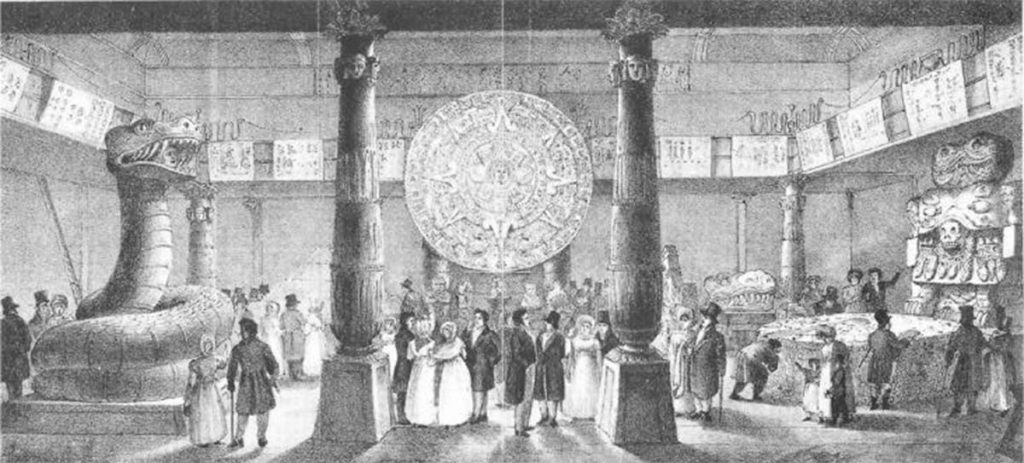Take a look at the picture below. It depicts an exhibition in London’s Piccadilly Hall held by William Bullock, entitled “Ancient Mexico” and showcasing Aztec artifacts and codices.

The year is 1824, and George IV is still on the throne. Queen Victoria is still Princess Alexandrina Victoria, a precocious 5-year-old girl being raised under strict supervision from her household in the hopes she will one day make an advantageous marriage to some European prince. Waterloo was less than a decade ago, and Napoleon is only recently dead.
This is an era of continued fascination with the wider world. British empire-building has encouraged the great liberal nation of the 19th century to look outwards, and the glitterati of London are fascinated with the far corners of the Earth, and all that is exotic.
And we can see from the picture that Bullock has gathered a rare collection of some of the most stunning Aztec treasures for his exhibition, mostly plaster casts from the original gathered in his travels the previous year. The engraving, by the Italian artist Agostino Aglio, is finely detailed and accurately depicts Aztec artifacts that we still safeguard to this day.
But, if the engraving is to be believed, Bullock’s exhibition also contains a strange mystery, one that remains unsolved.
The Unknown Statue
The problem arises when we catalogue the artifacts exhibited in the picture. The central circular object, for instance, is easy: it is the Aztec Sun Stone, also known as the Calendar Stone. Described here as “Montezuma’s watch” it is perhaps the most famous piece of Aztec iconography in the world.
Here also to the right we find the famous statue of Coatlicue, the Aztec goddess who gave birth to the Moon, the stars, and the god of the Sun and war. This andesite monolithic statue also survives to this day, and the engraving accurately depicts it in nearly every detail.
At the feet of Coatlicue lies the Tizoc Stone, also known as the Sacrificial Stone, another Aztec artifact. Rediscovered in 1791 in the Zocalo at the heart of downtown Mexico City, it was destined to be smashed into cobblestone until it was saved by a passing churchman.
And then to the left of the engraving, given arguably more prominence than anything else bar the Sun Stone, is an enormous statue of a rising serpent with a face peering from its mouth. And we have absolutely no idea what it is.
Nor is it easy to guess what it could be. Unlike the other artifacts, it looks nothing like surviving Aztec art and its very size should have guaranteed it got at least a mention elsewhere. Nor is it s one-off: other engravings of Bullock’s exhibitions also feature the enormous snake, complete with the peering face.
Was this some exhibit created solely for Bullock’s museum, to be destroyed afterwards (which raises the possibility that the face inside is a visitor who has ascended to some hidden interior platform)? Is this some unknown Aztec statue, hidden away and forgotten in some storage vault in London?
Or, most intriguingly, could this not be Aztec at all? Could Bullock have included in his exhibition some statue of an unknown culture, previously attributed as Aztec, which awaits rediscovery?
For now, nobody knows.
Top Image: The Unknown serpent statue can be seen in several engravings of Bullock’s exhibitions. Source: Agostino Aglio / Public Domain.
By Joseph Green